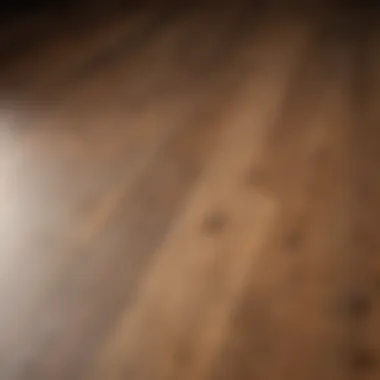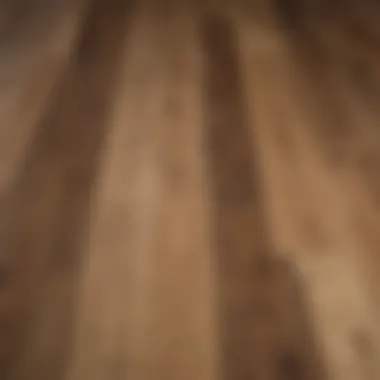Comprehensive Guide to Laminate Floor Treatment


Intro
Laminate flooring has become a staple in modern homes, offering an appealing balance between aesthetic value and durability. The importance of laminate floor treatment cannot be overstated; it plays a crucial role in maintaining the visual allure and functional integrity of these surfaces. Proper treatment not only enhances the longevity of laminate flooring but also enriches the overall design of any space. In this guide, we will explore various elements of laminate floor treatment, including types of laminate, maintenance processes, and effective cleaning methods.
The strategies discussed here are essential for homeowners and design enthusiasts alike. Understanding how to treat and maintain laminate flooring allows for the retention of its appearance and quality, ensuring that these surfaces withstand everyday wear and tear. Key topics include proper cleaning techniques, protective solutions, and common pitfalls to avoid, making this resource a valuable addition to anyone’s home improvement repertoire.
Home Design Inspiration
Architectural Styles
The choice of laminate flooring is often influenced by the architectural style of a home. Various designs can complement different types of laminate. For instance, contemporary homes may benefit from sleek, glossy finishes that reflect modern aesthetics, while traditional spaces might lean towards warmer, textured appearances. The right laminate selection enhances the inherent features of each architectural style, creating harmonious interiors.
Innovative Decor Trends
As trends in home decor evolve, laminate flooring continues to adapt and thrive. Natural wood patterns, for instance, are gaining popularity, providing the look of hardwood without the high maintenance. Additionally, the rise of eco-friendly materials has led to innovations in laminate that emphasize sustainability. Staying informed about these trends helps homeowners make choices that resonate with their personal style, while also keeping aligned with modern sensibilities.
Types of Laminate Flooring
Different types of laminate flooring serve varied purposes and aesthetics. Some commonly used laminate styles include:
- High-Gloss Laminate: Offers a sleek and polished look.
- Textured Laminate: Mimics natural finishes, providing depth and tactile quality.
- Water-Resistant Laminate: Designed to withstand moisture in spaces like kitchens and bathrooms.
Selecting the right type of laminate flooring is vital prior to any treatment methods. Each type may require specific care instructions to prolong its lifespan and beauty.
Treatment and Maintenance Processes
A well-formulated treatment plan for laminate floors consists of several steps. Initially, regular cleaning is essential. Here are useful tips for maintaining your laminate flooring:
- Routine Cleaning: Sweep or vacuum regularly to remove dirt and debris.
- Damp Mopping: Use a damp cloth or mop; excessive water can damage the laminate.
- Spot Cleaning: Address stains promptly with appropriate cleaners to prevent long-term damage.
In addition to cleaning, applying protective solutions can significantly boost the lifespan of laminate floors. Products like floor protectors can be set under furniture to avoid scratches. Moreover, using area rugs can also minimize wear in high-traffic spaces.
Proper upkeep ensures that laminate flooring not only remains aesthetically pleasing but also serves its function effectively over time.
Ending
Ultimately, understanding laminate floor treatment is key to enjoying beautifully maintained surfaces in your home. By selecting the appropriate types and adhering to treatment strategies discussed, homeowners can enhance their laminate flooring experience. Continuous education and attention to detail will lead to long-lasting results and satisfaction in your real estate ventures and design aspirations.
Understanding Laminate Flooring
Understanding laminate flooring is crucial in this article as it sets the foundation for everything that follows. Knowledge of its characteristics and types helps homeowners make informed decisions about care and treatment. This section delves into definitions, compositions, types, benefits, and other notable aspects essential in selecting and maintaining laminate flooring.
Definition and Composition
Laminate flooring is a multi-layer synthetic flooring product. It consists mainly of four layers: a backing layer for support, a core layer for stability, a design layer for aesthetics, and a wear layer for protection. The wear layer is usually made of melamine resin, which offers scratch resistance and protects against wear. This stacking of layers gives laminate its strength and durability. Understanding these components helps in knowing how to treat and maintain the flooring effectively.
Types of Laminate Flooring
There are three primary types of laminate flooring to consider, each with its own characteristics and suitability:
Standard Laminate
Standard laminate is well-known for its versatility. It is widely used in residential spaces due to its cost-effectiveness. It typically mimics the look of wood or stone, providing homeowners an attractive flooring option without a hefty price tag. A key characteristic is its ability to withstand moderate foot traffic, making it a favorable option for living rooms and bedrooms. However, it is essential to note that standard laminate is not water-resistant, which limits its placement in moisture-prone areas.
Water-Resistant Laminate
Water-resistant laminate is designed to handle humidity better than the standard type. It features enhanced core materials that resist moisture penetration. This characteristic makes it suitable for kitchens and bathrooms, where spills are common. The unique feature of water-resistant laminate is its ability to maintain its appearance and integrity over time, reducing the likelihood of water damage. Its downside may include a higher price compared to standard laminate.
High-Gloss Finish
High-gloss laminate is recognized for its shiny and sleek finish. This type adds a modern aesthetic appeal to any room. It reflects light in a way that can make small spaces seem larger and more open. A significant consideration with high-gloss finishes is that they are often more susceptible to scratches and fingerprints, necessitating more diligent cleaning and care. Homeowners should weigh the beauty against the practical upkeep required when choosing this type.


Benefits of Laminate Flooring
Several distinct benefits make laminate flooring an attractive choice for many homeowners:
Cost-Effectiveness
One prominent advantage of laminate flooring is its affordability. It offers an appealing solution for homeowners who want the luxurious look of hardwood without the related expenses. Laminate can mimic the aesthetic of more expensive flooring materials like hardwood, tile, or stone without the extensive financial commitment. The overall lower material and installation costs make laminate a smart choice for many budget-conscious renovators.
Variety of Designs
Laminate flooring comes in an extensive array of designs. This variety allows homeowners to choose from numerous colors, patterns, and finishes, enabling individual expression through flooring choices. Such flexibility ensures that laminate can complement any interior design style while maintaining functionality. It provides endless opportunities to enhance decor, making it a popular choice in modern homes.
Ease of Installation
The installation process of laminate flooring is relatively straightforward, especially with the click-lock technology that many brands now offer. This feature allows for easier DIY installations, reducing the time and labor typically required in traditional flooring. Less time spent on installation often leads to faster room completion, appealing to those who value efficiency in home improvement projects.
The Importance of Floor Treatment
Laminate flooring is a popular choice for many homeowners due to its appealing aesthetics and practical functionality. However, achieving maximum benefits from laminate flooring requires diligent floor treatment. This section illustrates the importance of proper treatment methods, which directly influences the longevity, appearance, and overall performance of laminate flooring. It is not merely an aesthetic concern; effective treatment ensures that your investment remains secure and flawless over the years.
Enhancing Longevity
The primary goal of laminate floor treatment is to extend the lifespan of your flooring. Over time, everyday use can lead to deterioration. Regular maintenance and appropriate treatments can significantly mitigate wear. An effective treatment plan can address potential issues before they escalate. Using protective coatings or sealants prevents damage from foot traffic and other daily activities. In addition, keeping the flooring clean and well-maintained prevents dirt from scratching the surface, thus maintaining its durability. By reinforcing the laminate's structure, treatment helps maintain its integrity for a longer period.
Improving Appearance
The visual appeal of laminate flooring can fade due to exposure to various factors. Routine treatment methods, such as cleaning and conditioning, greatly enhance the overall appearance. A well-maintained laminate floor radiates cleanliness and style. Beyond just cleaning, using specific products designed for laminate can restore shine, making spaces feel fresher and more inviting. The clear protective layer prevents discoloration from UV rays, ensuring that the original hues remain vibrant over time. This treatment effect is very crucial when it comes to showcasing any interior space.
Preventing Damage
Improper treatment can lead to serious issues. Addressing potential damage early through systematic treatment techniques is essential for maintaining the floor's health.
Scratches and Scuffs
Scratches and scuffs are common adversaries of laminate floors. When not addressed, these marks can detract from the floor’s visual appeal. Regularly treating these scratches involves using laminate-friendly cleaning products and custom solutions that prevent further erosion. The ability of treatments to fill in minor scratches preserves the floor's aesthetic and functionality. A characteristic feature of effective treatments is their capacity to rejuvenate and protect the surface without compromising the laminate's finish.
Stains and Water Damage
Stains and water damage can quickly turn an appealing floor into an eyesore. Using proper sealing products helps mitigate these risks. Sealants create a barrier against spills and splashes, which is particularly relevant in areas of high moisture, such as kitchens and bathrooms. The unique feature of effective floor treatments is their ability to integrate stain-resistant components while allowing the laminate to breathe. It's important to apply these treatments adequately to prevent water from seeping below the laminate, which can lead to further damage.
Proper treatment of laminate flooring not only preserves its beauty but also significantly increases its value over time.
Implementing regular treatments ensures that laminate floors remain a worthwhile investment. Thus, the importance of floor treatment cannot be overstated; it is vital for maintaining durability, enhancing visual appeal, and preventing various degrees of damage.
Preparation for Treatment
Preparation for treatment is critical when it comes to maintaining laminate flooring. Proper preparation ensures that the floor is ready for any cleaning or protective product applied. A well-prepared floor can significantly enhance the effectiveness of treatments, extending the lifespan and enhancing the appearance of the flooring.
A good preparation process includes assessing the current condition of the floor and performing a comprehensive cleaning. This step is necessary because laminate flooring can accumulate dirt, dust, and grime over time, which could hinder the adhesion of any treatments. Skipping this stage can lead to uneven results and may even damage the flooring. Therefore, ensuring thorough preparation is both a beneficial and necessary step.
Assessing Condition of the Floor
Before applying any treatment, it is essential to assess the condition of the laminate flooring. This assessment helps identify any visible signs of wear, such as scratches, dents, or fading. It is also crucial to look for any moisture-related issues or areas where the flooring may be lifting.
Taking time to evaluate these conditions can save homeoweners from future expensive repairs. Noticing small damages early can prevent them from becoming larger problems that are more challenging to fix. Homeowners should also check for discrepancies in the boards, such as gaps or misalignments, even subtle ones. They can address these issues properly before proceeding with treatments.
Cleaning the Surface
Once the condition of the floor has been assessed, the next step is cleaning the surface. Proper cleaning removes dirt, residues, and potential contaminants that may interfere with floor treatment. A clean surface is crucial for ensuring that products applied afterward will adhere correctly and perform effectively.
Types of Cleaners to Use


When selecting cleaners, choosing products specifically designed for laminate flooring is essential. These cleaners typically have unique formulations that avoid leaving streaks or damage, unlike general-purpose cleaners. Solutions like Bona Hard-Surface Floor Cleaner or Armstrong Once ‘n Done can be good choices. They are non-toxic and formulated to clean without harming the protective layer of the laminate.
Using the right cleaner can also enhance the overall look of your flooring, making it shine without causing deterioration. Avoid using abrasive products or materials that may scratch the surface. This avoids unnecessary wear and helps maintain the floor's finish over time.
Tools Required
The tools used for cleaning should be selected carefully, as they can impact the effectiveness of the cleaning process. Commonly needed tools include a microfiber mop, soft cloths, and a vacuum cleaner with a hard floor attachment. Microfiber mops are preferred because they are gentle on the surface and can trap dirt effectively.
Apart from being effective, using the correct tools saves time and effort. For instance, a vacuum cleaner equipped with the appropriate attachment can help reach into corners and tight spaces where normal mops may not fit. Having the right tools allow homeowners to clean more thoroughly, ensuring that the surface is completely ready for subsequent treatments.
Remember: Always allow the floor to dry completely before applying any type of treatment. Moisture can prevent treatments from adhering properly and may even lead to water damage.
Methods of Laminate Floor Treatment
Laminate floor treatment is crucial for maintaining its durability and aesthetics over time. The methods used can significantly affect the lifespan and performance of the flooring. Understanding the best treatment options helps homeowners protect their investment and maintain a pleasing environment in their homes. In this section, we will explore coating application, sealing processes, and routine maintenance treatments. Each of these methods plays a significant role in preserving the quality and appearance of laminate flooring.
Coating Application
Coating application involves the use of protective layers on the laminate surface to enhance durability and appearance. This method protects against scratches, stains, and general wear and tear. There are various types of coatings available, and choosing the right one is essential.
Types of Coatings
There are several types of coatings available for laminate floors. Polyurethane coatings are popular for their durability and scratch resistance. Another option is acrylic coatings, which are known for their easy application and quick drying time. Choosing the right type depends on your specific needs. Polyurethane provides better long-term protection but may require more time to apply.
The key characteristic of polyurethane is its strength, making it a beneficial choice for high-traffic areas. Acrylic, while easier to apply, may need more frequent reapplication. Make sure to weigh the pros and cons before making a decision.
Application Techniques
Proper application techniques are vital for successful coating. Brush application is common but may leave streaks. Roller application provides a more even finish, especially on larger areas. Another option is using spray application for quick and uniform coverage.
Choosing the right technique can enhance the effectiveness. Roller application is less labor-intensive and offers a smooth finish. However, it may take longer than spray application, which allows for fast coverage but needs practice for an even coat. Always follow manufacturer instructions during this process for best results.
Sealing Processes
Sealing processes are equally important in laminate floor treatment. They add an extra layer of protection against moisture and enhance overall appearance. There are various types of sealants that cater to different requirements.
Types of Sealants
The most common types of sealants include water-based sealants and oil-based sealants. Water-based sealants dry faster and have low odor, making them suitable for indoor use. Oil-based sealants offer better protection against water damage but take longer to dry.
The key feature of water-based sealants is their quick-drying property, making them a popular choice for busy homeowners. While oil-based sealants provide excellent moisture resistance, they can emit stronger fumes and require more ventilation. Careful consideration of sealant type can lead to better long-term results.
Application Timing
Application timing is critical when sealing laminate floors. Ideally, sealing should occur after any necessary repairs and thorough cleaning. This ensures that the sealant adheres correctly and maximizes its protective qualities.
Applying sealant too early or too late can lead to poor adhesion and reduced effectiveness. It is beneficial to check humidity levels before applying, as excessive moisture can affect curing. Proper timing ensures that the protective layer bonds effectively and lasts longer.
Routine Maintenance Treatments
Routine maintenance is necessary to keep laminate flooring in optimal condition. Regular treatments can significantly prolong the lifespan of the flooring and enhance its appearance over time.
Frequency of Treatment
The frequency of treatment depends on various factors such as foot traffic and environmental conditions. High-traffic areas may require more frequent maintenance compared to low-traffic zones. As a general guideline, routine treatments should be conducted every six months to a year.
The key characteristic of regular maintenance is its preventive nature. By establishing a consistent schedule, you can avoid potential damage and costly repairs down the line. This proactive approach helps maintain the visual appeal of your laminate floors.
Seasonal Considerations
Seasonal changes can greatly affect the treatment of laminate flooring. In winter, the humidity tends to drop, which can cause the laminate to shrink. In summer, higher humidity can lead to expansion. Therefore, adjusting your maintenance schedule according to seasons is vital.


A unique feature of seasonal considerations is the need for flexibility. You might need to increase maintenance in humid months or decrease it during drier months. This adaptability can help in achieving optimal performance and durability for your flooring throughout the year.
Regular care is necessary for retaining both durability and aesthetic appeal.
Each of these methods contributes to the overall longevity and satisfaction of laminate flooring. Understanding coating applications, sealing processes, and routine maintenance treatments will allow homeowners to make informed decisions and enjoy a beautiful, functional space.
Post-Treatment Care
Post-treatment care is a crucial aspect of maintaining laminate flooring after applying cleaning solutions or protective coatings. The steps taken during this phase will significantly impact the overall durability and appearance of the floor. Proper care ensures that the initial treatment achieves its desired effects and extends the life of the flooring. This section covers essential practices that homeowners should adopt post-treatment.
Routine Cleaning Practices
Having established an effective treatment plan, routine cleaning practices become essential for sustaining the benefits of laminate flooring. Regular cleaning helps to eliminate dirt and dust that can accumulate and lead to deterioration over time. Here are some key practices to follow:
- Use Suitable Cleaners: Always opt for cleaners specifically formulated for laminate floors. Using harsh chemicals can lead to damage or discoloration of the surface.
- Dry Mopping: For daily upkeep, dry mopping with a microfiber cloth is advisable. This method collects dust and particulate matter without adding moisture that could seep into seams.
- Spot Cleaning: Any spills should be addressed immediately to prevent stains. Use a damp cloth to blot the area gently rather than scrubbing, which can scratch the laminate.
- Avoid Excess Water: When deep cleaning, avoid saturating the floor. Excess water can warp the material and lead to more severe issues.
Inspecting for Damage
Regular inspection is an important part of post-treatment care. Over time, various factors can cause damage to laminate flooring, including heavy foot traffic and environmental conditions. An ongoing assessment can help catch problems early. Here are ways to effectively inspect your floors:
- Visual Checks: Periodically, conduct a visual inspection of your laminate flooring. Look for signs of scratches, chips, or areas that may appear discolored. Catching these changes early allows for timely repairs.
- Check for Moisture: Pay attention to any areas where moisture might be trapped. This could lead to lasting damage if left unresolved.
- Listen for Noises: When walking on the floor, notice any unusual sounds. Creaking or popping noises could signal issues with underlying support or installation that need immediate attention.
Regular inspections can save you from unexpected repair costs and keep your laminate flooring looking its best.
By engaging in these post-treatment practices, homeowners can ensure that their laminate flooring remains not only functional but also visually appealing. Paying attention to cleaning and inspection details ensures durability and extends the life of your investment.
Common Mistakes in Laminated Floor Treatment
When caring for laminate flooring, the decisions made during the treatment process can significantly influence its longevity and appearance. Many homeowners make mistakes that can lead to costly repairs and diminished aesthetics. By understanding these common errors, one can adopt better practices that enhance the flooring's lifespan and performance.
Using Incorrect Cleaners
Selecting the right cleaner for laminate floors is critical. Incorrect products can cause discoloration, damage the protective layer, or leave a residue that attracts dirt and grime. Many people use harsh chemicals or products not intended for laminate.
- Avoid using:
- Ammonia-based cleaners, which can strip the finish.
- Oil soaps, as they can create a slippery surface and make cleaning difficult.
- Any product labeled as "wax" or "polish," since these are designed for hardwood, not laminate.
Instead, opt for cleaners specifically formulated for laminate surfaces. This ensures that the cleaner will effectively remove dirt without harming the floor's finish. Read ingredients carefully and seek recommendations from reliable sources.
* Using the wrong cleaner may void warranties and lead to costly refinishing or replacement in the long run. Taking care to use appropriate cleaning products is essential.
Neglecting Regular Maintenance
Regular maintenance is essential in preserving the beauty and integrity of laminated flooring. Skipping routine tasks can result in more serious issues down the line. Common maintenance oversights include:
- Lack of Cleaning: Regular sweeping or vacuuming is needed to remove debris that can scratch the surface. Waiting too long can lead to build-up, making maintenance more challenging.
- Ignoring Spills: Promptly addressing spills can prevent stains and swelling. Laminate is water-resistant, but it is not waterproof. Long exposure to moisture can cause damage.
- Failure to Create a Schedule: Establishing a cleaning and treatment schedule can help ensure that maintenance tasks are not forgotten. This includes deep cleaning, applying protective treatments, and inspecting for damage.
By prioritizing maintenance, homeowners can enhance their flooring experience and reduce future repair costs. Having a disciplined approach will ensure that the laminate floor continues to look fresh and withstand daily use.
Ending
In the realm of laminate flooring, understanding the treatment process is paramount. It not only preserves the integrity of the floor but also plays a crucial role in enhancing its visual appeal. Proper treatment can lead to significant advantages, making it a worthwhile investment for any homeowner. With laminate flooring's durability and versatility, recognizing the specific needs of maintenance ensures that the flooring remains functional over time.
Summary of Core Points
This article has covered several crucial aspects of laminate floor treatment. Key points include:
- Understanding the Composition: Different types of laminate floors require tailored treatment strategies.
- Importance of Treatment: Regular maintenance can extend the life of your floors and minimize damage.
- Methods of Treatment: Coating, sealing, and routine maintenance are essential to ensure a pristine finish.
- Common Mistakes to Avoid: Choosing unsuitable cleaners and neglecting regular upkeep can lead to problems that may compromise the floor’s quality.
Final Recommendations for Homeowners
To maximize the longevity and appearance of laminate flooring, homeowners should consider the following recommendations:
- Choose the Right Cleaning Products: Always use cleaners recommended for laminate floors to avoid potential damage.
- Establish a Regular Maintenance Schedule: Regular inspections and cleaning routines help catch issues early and maintain aesthetics.
- Know When to Treat: Seasonal changes can affect the floor's condition, so adapt your treatment routine accordingly.
- Invest in Quality Treatments: Use high-quality sealants and coatings for long-lasting results.
"Investing time and care into laminate floor treatment not only preserves a home's beauty but also enhances property value."
By adhering to these principles, homeowners can enjoy their laminate floors for years to come, ensuring they remain both functional and beautiful.







